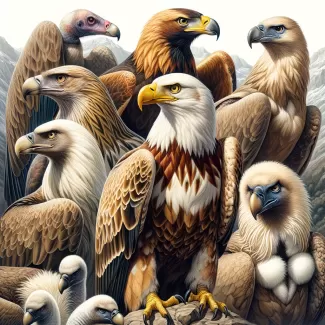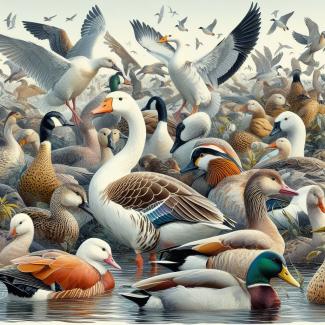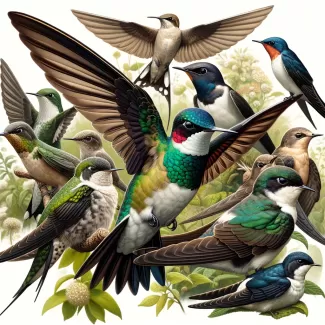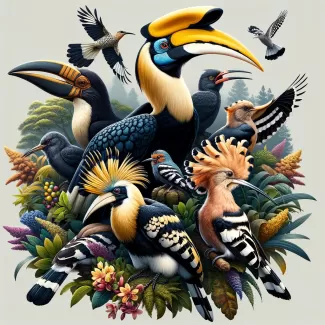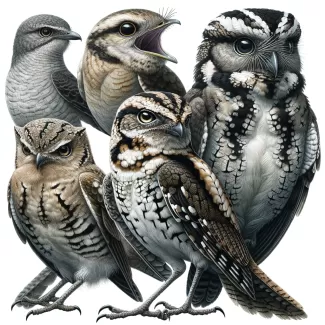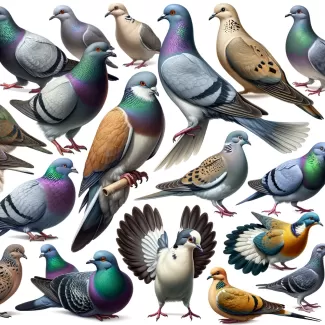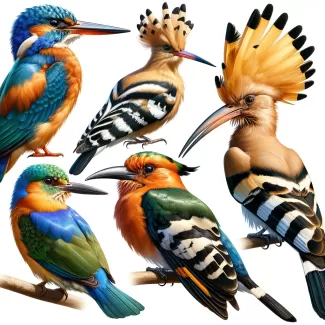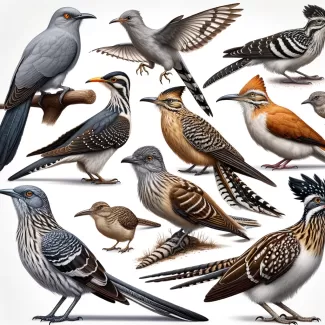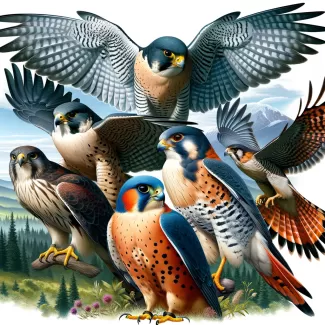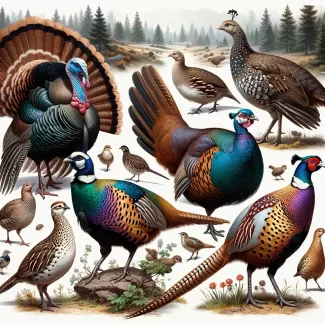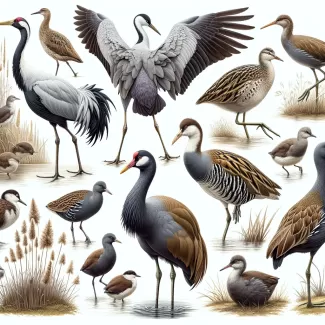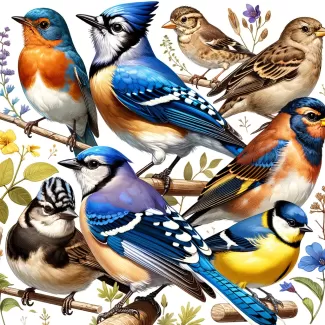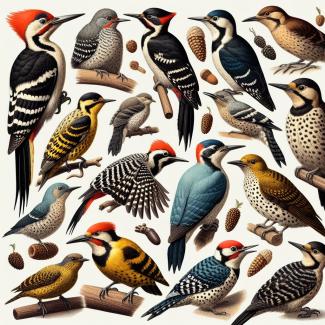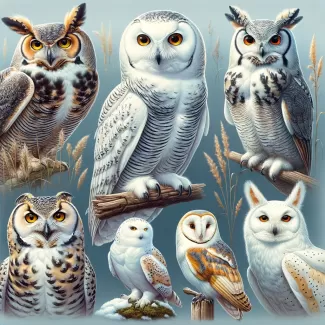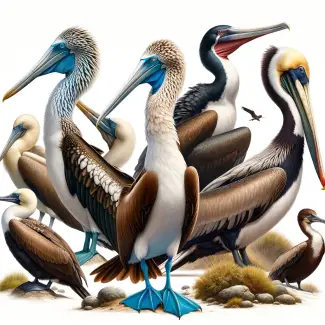Birds of Nepal - Bird Identification
Nepal is a treasure trove of diverse ecosystems, boasting an incredible array of bird species. Always remember: "Bird identification is practice more than skill". Bird, the feathered friends can provide a profound appreciation for the nation's rich biodiversity. Here's an easy-to-follow guide to pinpointing various birds in Nepal:
- Step 1: Get Acquainted with the Habitat
-
Due to its varied landscapes, from the low-lying Terai plains to the towering Himalayas, Nepal is home to distinct bird species. Begin by observing where the bird resides. For example, you'll frequently find wetland avians like herons and storks in the Terai region, while pheasants and snowcocks dwell in mountainous areas.
- Step 2: Notice General Traits
-
Pay attention to the bird's size, shape, hue, and behavior as these aspects can hint at its order – a broad class that groups birds sharing similar features. For instance, passerines or perching birds are typically small to medium-sized and often perch on trees or bushes.
- Step 3: Inspect Specific Details
-
After determining the order, zoom in on peculiar attributes to identify the bird's family. You can focus on aspects like beak shape, leg structure, and feeding practices. For example, corvids (i.e., crows and jays) possess sturdy, stout beaks.
- Step 4: Eavesdrop on Bird Calls
-
Bird calls serve as handy aids for identification since many species boast unique songs or noises. Numerous online resources and guidebooks provide audio recordings of Nepalese bird calls.
- Step 5: Take Advantage of a Field Guide
-
A field guide dedicated to Nepalese birds proves invaluable for recognizing various species. These books offer comprehensive illustrations and descriptions that simplify identification.
- Step 6: Join Forces with a Birdwatching Group
-
Participating in birdwatching groups or guided tours equips you with useful insights that enhance your identification skills. Expert guides and fellow bird enthusiasts can teach valuable tips and help you spot species you might overlook on your own.
Again, Keep in mind that proficiency in bird identification grows with time and practice. Practice patience, maintain an observant attitude, and gradually, you'll master the art of spotting Nepal's unique birdlife.
Our aim is to develop a comprehensive and trustworthy source of information that highlights the rich variety of bird species that grace this stunning nation. Hereby, you need to build fundamental knowledge of bird taxonomic classification that will help you recognize bird species easily.
- Step 1: Categorize by Order
-
Begin the bird identification process by sorting them into orders according to their shared characteristics. For instance, 'Passeriformes' comprises perching and songbirds, while 'Anseriformes' encompasses ducks, geese, and swans. Evaluate elements like size, shape, behavior, and environment to identify the correct order.
- Step 2: Identify the Family
-
After establishing the bird's order, it's vital to determine its family. Each order contains multiple families that exhibit distinct common features. For example, within the Passeriformes order, you'll come across families such as 'Fringillidae' (finches) or 'Corvidae' (crows and jays). Concentrate on characteristics like beak shape, foot structure, and feeding practices at this point.
- Step 3: Determine the Subfamily (if required)
-
Occasionally, particularly in larger families, it may be essential to pinpoint a bird's subfamily. These groupings include species that are more closely related than other members of the same family. Take for example the 'Corvidae' crow family – it consists of subfamilies like 'Corvinae' (true crows) and 'Garrulinae' (jays). Focus on subtle distinctions such as vocalizations, mating rituals, or distinct physical features to accurately identify the subfamily.
- Step 4: Specify the Genus
-
Lastly, complete the bird identification process by discerning its genus—a set of species united by a common ancestor. Within the jay subfamily 'Garrulinae', you'll encounter genera like 'Garrulus' (Eurasian jays) and 'Cyanocitta' (blue jays). Observe minute details like feather coloration and patterns, egg appearances and shades, or unique vocalizations during this final phase.
In the Right Sidebar, you'll find a comprehensive list of bird orders representing various bird species of Nepal. You can navigate through the orders to explore families, subfamilies, and genera. By delving into the species within each category, you'll gain a deeper understanding of Nepal's avian diversity.
Birdwatching Equipments
As you are eager to dive into the world of birdwatching in Nepal! Let's explore some specially curated tips and tools designed just for this amazing experience:
Essential Gear
Binoculars: Nepal's diverse terrain calls for a versatile companion like the Nikon Monarch 7 8x42. Its 8x magnification and 42mm objective lens offer a wide, bright view, perfect for all the unique landscapes you'll encounter.
Field Guides: "Birds of Nepal" by Richard Grimmett, Carol Inskipp, and Tim Inskipp is your go-to guide, featuring detailed illustrations of the many species found throughout Nepal.
Camera: For those breathtaking shots, the Nikon P1000 and its impressive 125x optical zoom guarantee stunning images without disturbing our feathered friends.
Notebook and Pen: Equip yourself with a waterproof notebook like the Rite in the Rain series - a lifesaver during Nepal's monsoon season.
Must-Have Birdwatching Apps
eBird: Powered by the Cornell Lab of Ornithology, eBird brings global expertise to local Nepalese birdwatching. Log your sightings, explore recent discoveries in the area, and even join fun challenges!
Merlin Bird ID: Another gem from the Cornell Lab, this app offers photo identification and an Indian subcontinent pack that includes several species found in Nepal. A great choice for beginners!
Most Importantly: Tap into Local Knowledge
Bird Conservation Nepal (BCN): Link up with organizations like BCN for priceless local insights. They regularly host birdwatching trips, workshops, and events that will enrich your experience even further.
Birdwatching in Nepal: A Unique and Rewarding Experience
Nepal, nestled amidst the towering peaks of the Himalayas and the dense jungles of the Terai, offers a unique birdwatching experience quite unlike coastal or plain regions. The country's diverse topography and altitude variations make it a haven for over 900 bird species. However, birdwatching in Nepal comes with its own set of challenges and rewards.
Best Times of Day for Birdwatching in Nepal
Early Morning: The serene hours just after sunrise are magical in Nepal. As the first rays of the sun pierce through the misty mountains and dense forests, birds begin their daily routines. They are most active during these hours, foraging for food and marking their territories with melodious calls. The cool mountain air combined with the symphony of bird songs makes early mornings the prime time for birdwatching.
Late Afternoon: As the sun begins its descent, casting a golden hue over Nepal's landscapes, many birds become active once again. The drop in temperature, especially in hilly regions, encourages birds to venture out, making late afternoons another opportune time for spotting.
Avoid Midday: Nepal's diverse climate means that midday temperatures can soar, especially in the Terai region. During these scorching hours, birds seek refuge in shaded areas, making them harder to spot. It's advisable for birdwatchers to take a break during this time and resume their exploration later.
Techniques for Spotting and Identifying Birds in Nepal
Listen Carefully: The dense forests and rugged terrains of Nepal mean that often, you'll rely on your ears more than your eyes. The calls of birds like the melodious Laughingthrush or the echoing Cuckoo can guide you to their locations. It's beneficial to familiarize oneself with the calls of common Nepali birds, as this can significantly aid in identification.
Move Slowly and Quietly: The pristine nature of many of Nepal's birdwatching spots means that birds here are not accustomed to human presence. Any sudden movement or loud noise can easily scare them away. Adopting a slow, deliberate pace and minimizing noise ensures that you don't disturb the birds and can observe them in their natural behavior.
Look for Movement: Some of Nepal's birds, like the elusive Spiny Babbler or the majestic Himalayan Monal, have plumages that blend seamlessly with their surroundings. Instead of looking for color, watch out for any movement in the foliage or on the ground. A fluttering leaf or a shadow darting across the path can often lead to a rewarding sighting.
Use Silhouette and Behavior: In the dense rhododendron forests or the misty jungles, lighting might not always be your ally. In such scenarios, observing the silhouette, flight pattern, and behavior of birds can be more informative than their color. For instance, the distinct flight pattern of eagles or the hopping behavior of sunbirds can provide valuable identification clues.
In conclusion, birdwatching in Nepal, while challenging, is an immensely rewarding experience. The country's unparalleled biodiversity, combined with its breathtaking landscapes, ensures that every birdwatching trip is filled with discoveries and memories to cherish.
Birdwatching Expeditions in Nepal: Discovering Avian Diversity and Habitat Treasures
- Altitude Adventures
-
In contrast to birds from other places flying far and wide, Nepal's avian inhabitants have their unique style. They migrate up and down in elevation depending on the season. This means you'll encounter various species at the same spot throughout the year, making birdwatching even more exciting.
- Seek Special Habitats
-
Some birds, like the enchanting Red Panda Warbler, are exclusive residents of rhododendron forests. By knowing and focusing on these specialized zones, you can up your chances of spotting such singular species and make each outing even more gratifying.
- Tune into Nature's Playlist
-
Nepal's dense forests might limit visuals, but they can't muffle distinctive bird songs like that of the Chestnut-headed Tesia. Learn to recognize these unique tunes to locate and spot otherwise hidden birdlife.
- Dressed for the Season
-
Birds such as the vibrant Himalayan Monal change plumage according to seasonal cues. Observing these transformations not only helps in identification but also deepens your understanding of their adaptation skills and life cycles.
- Water Hotspots Aplenty:
-
In dry spells, water sources transform into bustling bird hubs. Watch Ibisbills and other feathered visitors flock to rivers and lakes – perfect hotspots for memorable birdwatching experiences.
- Crepuscular Chronicles
-
Early mornings and late evenings are prime times for active birds like Hodgson's Frogmouth. Plan your birdwatching sessions around these tranquil moments for heightened sightings and an immersive experience in Nepal's stunning landscapes.
- High Altitude Hideaways
-
For mountain enthusiasts, species like the Snow Pigeon inhabit specific elevations. By grasping these preferences, you can tailor your treks to meet your feathered friends where they feel most at home.
- Showtime Breeding Season:
-
Witness birds like the Satyr Tragopan in their most dazzling attire performing fascinating rituals during mating season. Timing your trips right, will reward you with these visual feasts and a closer look at avian courtship.
- Flocking Together
-
Catch glimpses of social behaviors and the fascinating dynamics of bird communities like the Nepal Fulvetta. Observing their group interactions adds a unique touch to your birdwatching expedition.
- Sage Local Wisdom
-
Embrace the boundless knowledge of local guides, especially in rich ecosystems like the Annapurna Conservation Area. Not only do you contribute to local livelihoods, but you'll also unveil traditional, lesser-known birdwatching secrets.
- Biodiversity Bonanzas
-
Make visiting spots like Chitwan National Park your priority. Not only do they host a plethora of species, but your visit also aids in conservation efforts for preserving these birds for generations to come.
By diving deeper into these tips and fully embracing the intricate world of Nepal's avifauna, every birdwatcher can heighten their experience, turning each journey into a captivating mix of education and wonder.

